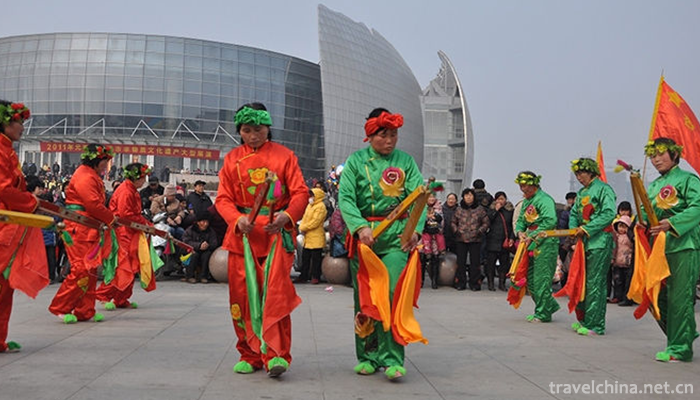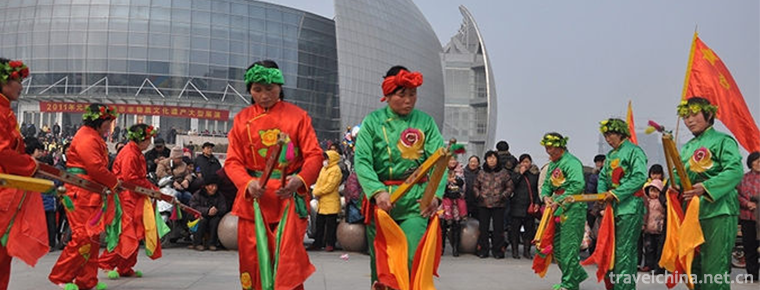Shangyang Dance
Shangyang Dance
Shangyang Dance, a traditional folk dance in Juancheng County, Shandong Province, is one of the national intangible cultural heritage.
Shangyang Dance originated in the northern part of Juancheng County and spread around Li Jinshitang Town and Old Town. It is represented by Xinggrang Village of Li Jinshitang Town. According to textual research, this dance originated in Shang and Zhou Dynasties, matured in the Spring and Autumn Period and the Warring States Period, and flourished in the Song and Ming Dynasties.
On June 7, 2008, Shangyang Dance was approved by the State Council of the People's Republic of China to be included in the second batch of national intangible cultural heritage list, the heritage number: III-49.
historical origin
"Shangyang Dance" is a kind of ancient sacrificial folk dance, which spreads around Xinggrang Village, Jiuyu Township, Juancheng County, Heze City. Juanyi in the Spring and Autumn Period was located on the Bank of the Yellow River in the contemporary era. By the Warring States Period, Juanyi was already a very prosperous city. According to "Puzhou Zhi. Historic Site", it said: "There are apricot granites in the three miles northeast of the old city." Is one of the eight scenic spots in Puzhou, "Xinggang spring red ten miles, night to listen to Gulin hit the evening bell" origin. The "Shang Yang Dance", which originated from the ancient apricot granite, continued after thousands of years.
The written record of Shang Yang Dance was first found in Confucius Jiayu. Documentation: "Qi has enough birds, flying in the Gong Dynasty, down to the front of the palace, jumping with ease of wings, Qi Hou weird. When he hired Lu to confucius, Confucius said, "This bird is called Shang Yang, and the water sample is also like this." It's raining heavily and the merchant sheep are encouraged. Now it's all there. It's time to call on the people urgently. There will be floods and heavy rains on hectares, flooding all countries and hurting the people. Only when we are ready and invincible can we build dikes and ditches.
Pu Songling in the Qing Dynasty also described the Shang Yang Dance in his "Dancing God" chapter of "Strange Tales from a Liaozhai Studio": "Women wear short skirts to make Shang Yang Dance." At the end of the Qing Dynasty, Jinan and Beijing invited witches to be God dancers, all of them succeeded in "Shangyang Dance". The primitive and simple "Shangyang Dance" adds some mystery to it because of the wizard's use in dancing to catch ghosts and gods.
In 1956, four literary and artistic workers from the Political Department of the Beijing Military Region came to Juancheng to rehearse the Shang Yang Dance with the artists who danced the Shang Yang Dance. These four artists repeatedly told the dancers that the Shang Yang Dance was an endangered ancient dance, and only the apricot granite remained in China, hoping to attract attention and be passed down from generation to generation. In the same year, Zhao Zilin, a dancing beauty worker in the county cultural hall, excavated and sorted out the Shang Yang Dance and moved it to the art stage to participate in the folk dance concert in Shandong Province.
In January 2005, the Chinese Opera Research Institute and some experts and professors from the Music Department of Shandong Normal University attended the performance of Shangyang Dance in Xinggrang. In contemporary times, Shang Yang Dance is again active among the people in Juancheng, sometimes performing simultaneously with such folk art forms as stilts, floats, early boats, dragon and lion dances.
In April 2007, Juancheng County Bureau of Culture and Sports appointed a special person to discuss with the old artists in Xinggrang, recorded the Shangyang Dance in writing and recorded the video, and made a careful register of the genealogical inheritors of the dance.
Inheritance and Protection
Inheritance value
Shang Yang Dance is a folk dance with local and folk characteristics. It is deeply rooted in rural folklore. For thousands of years, it has been an art form loved by the working people and a "local treasure" in the treasure house of Chinese traditional culture. It is a prominent manifestation of Juancheng people's traditional culture. It contains the spirit of expectation, belief, value orientation, and involves all aspects of Juancheng Festival customs. It has the special value of Anthropology and folklore research materials, and has attracted the attention of Chinese and foreign academic circles.
Heritage figures
Chen Yuying, female, the representative successor of the fifth batch of national intangible cultural heritage projects (Shangyang Dance), was declared by Juancheng County, Shandong Province.
protective measures
In 1956, after the excavation and arrangement of Zhao Zilin, an old artist, Shangyang Dance was put on the cultural stage.
In 1990, Shangyang Dance was included in the Folk Dance Chapter of the Great Dictionary of Chinese Folk Art.
In October 1995, Juancheng County Culture and Sports Bureau and Radio and Television Bureau jointly reorganized and restored Shangyang Dance, started to select and train new people, and recorded the "Shangyang Dance" CD-ROM.
In 2006, Shangyang Dance was listed in Shandong intangible cultural heritage list by the State Council of the People's Republic of China.
In August 2014, the Dance Academy of Shandong Art Academy "Research Shandong" team went to Heze Juancheng County to carry out a field research entitled "Feasibility Investigation of Shandong intangible cultural heritage dance into classroom - Take Shangyang Dance in Juancheng County as an example".
social influence
On September 14, 2018, Shang Yang Dance, which was promoted by Juancheng County, appeared as the only folk dance selected by Heze in the performance of Beijing National Theatre, demonstrating Juancheng culture and characteristics of folk dance.
On September 25, 2018, Shang Yang Dance was displayed in Heze Peasant Games and Juancheng First Peasant Games, which celebrated the "Chinese Peasant Harvest Festival".


-
1.Shanghai Gulf National Forest Park
Shanghai Bay National Forest Park is located in the May 4th Farm of Haiwan Town, Fengxian District, Shanghai, 60 kilometers from the center of Shanghai. It is a large artificial urban ecological fores
Time 2018-12-19 -
2.Tongzhou Forest Park of Grand Canal
Tongzhou Forest Park of the Grand Canal is located on both sides of the North Canal of Tongzhou New Town, Beijing. It starts from Luyang Bridge on the Sixth Ring Road in the north and Wuyao Bridge in
Time 2019-01-07 -
3.The official will ring Gong
Official Guild gongs are widely spread in rural areas of Eastern Henan Province. It is a traditional percussion instrument with brass gongs as props. It has a history of more than 300 years
Time 2019-05-01 -
4.Cutting Skill of Kaner Well
Kanerjing is the meaning of "well hole". It has been recorded as early as in Historical Records. It is called "well canal", while Xinjiang Uygur language is called "Kanerzi&qu
Time 2019-05-08 -
5.Maoshan chant
Maoshan chant is a traditional folk song originating in Maoshan area of Xinghua City, Jiangsu Province. It is a kind of folk song that people in Maoshan use chant form with chant words to stimulate em
Time 2019-05-28 -
6.Mongolian Medicine
Mongolian medicine is mainly moxibustion, and is good at using fire needles. Fire needle is a method of treating diseases by rapidly puncturing the acupoints with red-hot needle tips. This method has
Time 2019-06-04 -
7.Wulin Diao
Wulin Diao evolved from the folk propaganda of Baojuan and formed in the late Qing Dynasty. The performance form of Wulin tune is mainly sitting and singing, which combines narrative and singing. One
Time 2019-06-30 -
8.Proverbs Shanghai Proverbs
Shanghai proverb, also known as Shanghai proverb, is the traditional folk oral literature in Shanghai. Local gossip. It belongs to one of the national intangible heritage.
Time 2019-07-10 -
9.Flag dress of Qing Dynasty
In the strong feudal ethical atmosphere of the Qing Dynasty, it is impossible for women to show their curves as modern. In the Qing Dynasty, the cutting system of flag dress always adopted straight line, and the chest, shoulder, waist and buttocks were
Time 2020-12-11 -
10.Cheongsam and fan
As the saying goes, the pipa is half covered. What did ancient beauties use to cover their faces? The first reaction must be a fan! Fans are also the most common accessories in ancient times. Men use paper fans and women use round fans. Chinese traditional fan culture
Time 2020-12-11 -
11.Social security in Luzhou
By the end of 2017, the total number of participants in basic endowment insurance in Luzhou city was 2662800, an increase of 130700 compared with the end of the previous year. At the end of the year, 1031700 people participated in the basic endowment insurance for urban employees
Time 2020-12-14 -
12.Nanchong economy
In 2019, Nanchong's GDP will reach 232.222 billion yuan, an increase of 8.0% over that of 2018. Among them, the added value of the primary industry was 40.425 billion yuan, an increase of 2.9% over 2018; the added value of the secondary industry was
Time 2020-12-17